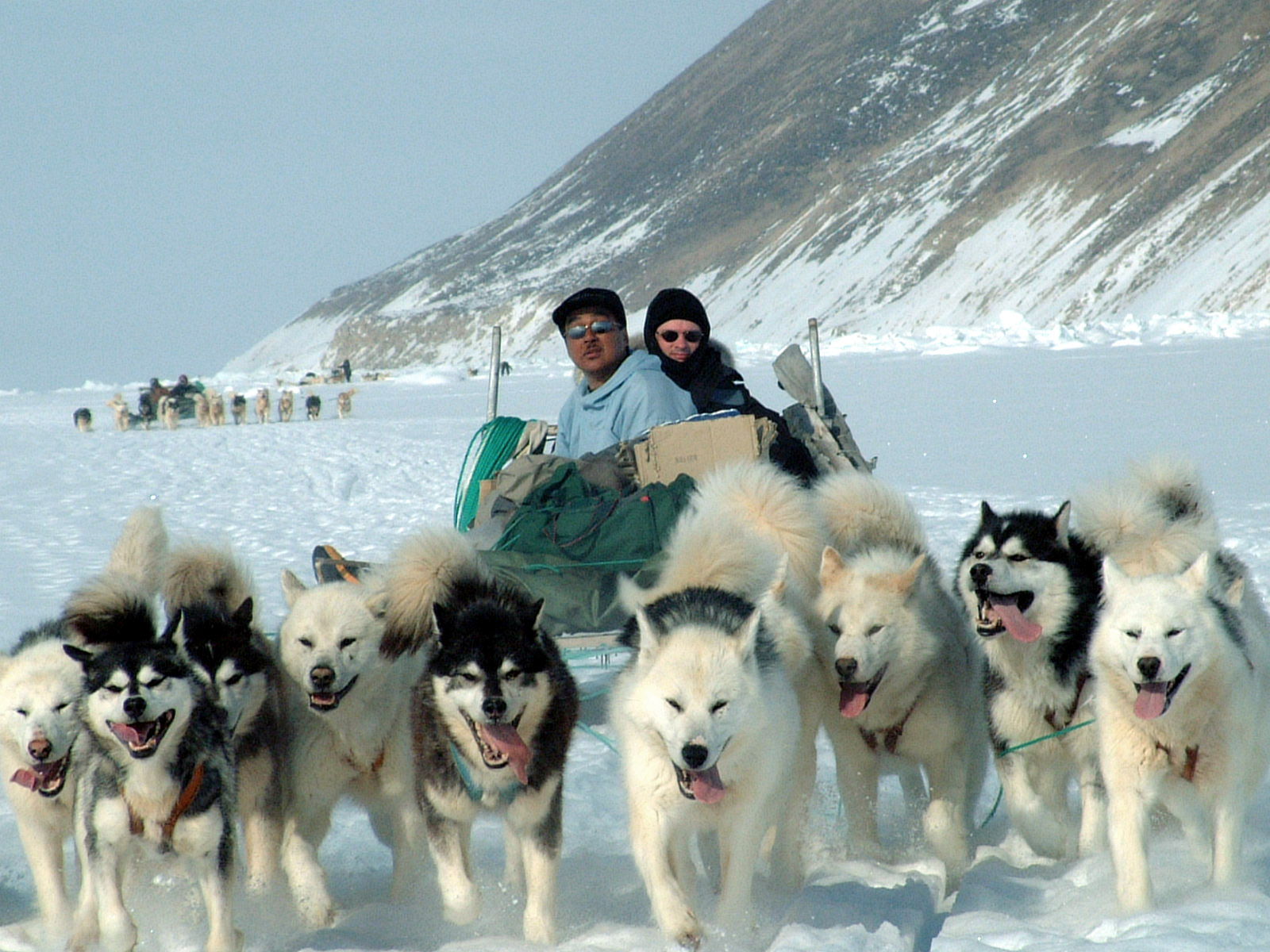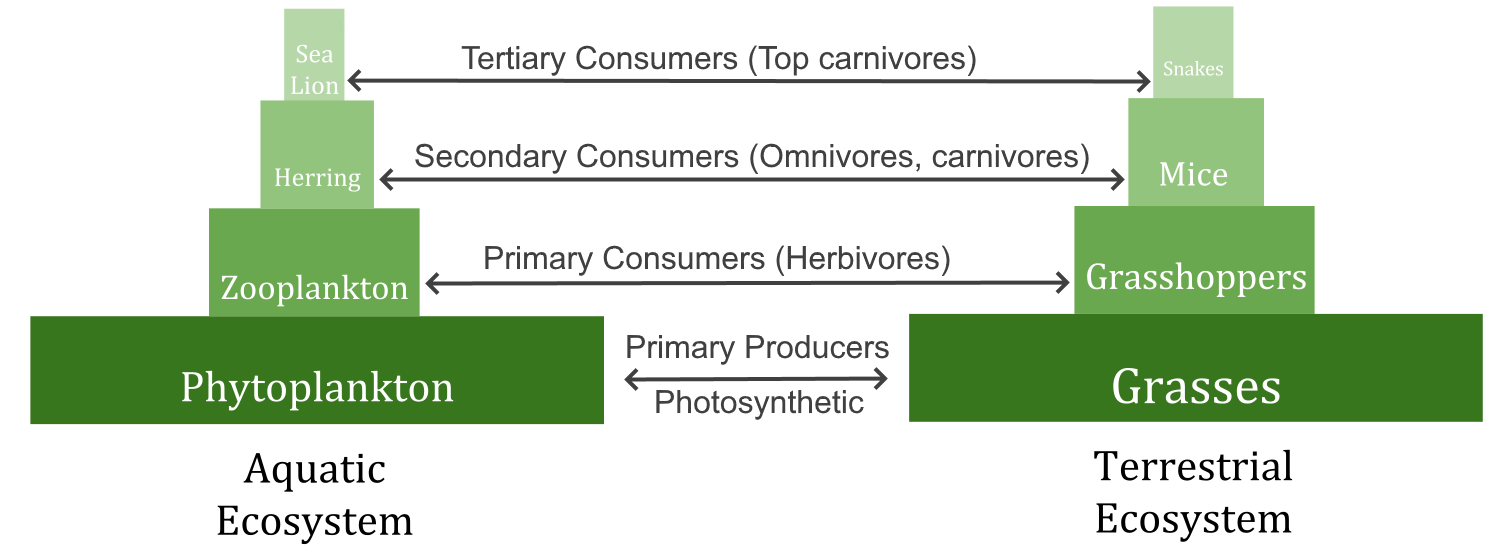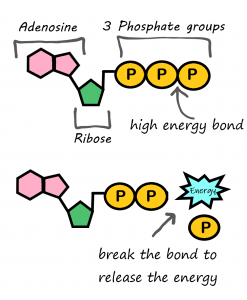Active Reading Energy in Living Things Answers
4.nine Free energy Needs of Living Things
Created past: CK-12/Adjusted by Christine Miller
Mush!

These beautiful sled dogs are a metabolic curiosity. While running up to 160 kilometres (near 99 miles) a day, they will each consume and burn about 12 g calories — about 240 calories per pound per day, which is the equivalent of near 24 Big Macs! A human endurance athlete, in contrast, typically burns only almost 100 calories per pound (0.45 kg) each solar day. Scientists are intrigued by the amazing metabolism of sled dogs, although they still haven't determined how they use up then much energy. But one thing is sure: all living things need free energy for everything they practise, whether it'south running a race or blinking an eye. In fact, every jail cell of your trunk constantly needs energy just to comport out basic life processes. You probably know that you get energy from the food you eat, but where does nutrient come from? How does information technology come to contain energy? And how practise your cells get the energy from food?
What Is Energy?
In the scientific earth, is divers equally the ability to do piece of work. Yous can ofttimes see energy at work in living things — a bird flies through the air, a firefly glows in the dark, a dog wags its tail. These are obvious ways that living things utilize energy, just living things constantly apply energy in less obvious ways, equally well.
Why Living Things Demand Energy
Inside every of all living things, energy is needed to carry out life processes. Free energy is required to interruption down and build up molecules, and to transport many molecules across plasma membranes. All of life's piece of work needs energy. A lot of energy is also but lost to the surroundings as heat. The story of life is a story of energy flow — its capture, its modify of form, its use for work, and its loss every bit rut. Energy (unlike matter) cannot be recycled, so organisms require a constant input of energy. Life runs on chemical energy. Where practise living organisms get this chemical energy?
How Organisms Go Free energy
The chemic energy that organisms need comes from food.consists of organic molecules that store energy in their chemical bonds. In terms of obtaining food for energy, at that place are two types of organisms: autotrophs and heterotrophs.
Autotrophs
are organisms that capture from nonliving sources and transfer that energy into the living part of the ecosystem. They are also able to make their ain food. Near autotrophs use the free energy in sunlight to brand food in the procedure of. Merely certain organisms — such equally plants, algae, and some bacteria — can make food through photosynthesis. Some photosynthetic organisms are shown in Figure 4.9.two.
are also called. They produce food not only for themselves, but for all other living things (known equally consumers), equally well. This is why autotrophs course the ground of food bondage, such as the food chain shown In Figure four.9.3.

A food chain shows how energy and matter period from producers to consumers. Thing is recycled, simply free energy must go along flowing into the system. Where does this energy come from?
Watch the video "The simple story of photosynthesis and food – Amanda Ooten" from TED-Ed to learn more about photosynthesis:
The simple story of photosynthesis and food – Amanda Ooten, TED-Ed, 2013.
Heterotrophs
are living things that cannot make their own food. Instead, they get their food by consuming other organisms, which is why they are also called. They may consume or other . Heterotrophs include all animals and fungi, too every bit many single-celled organisms. In Figure 4.9.3, all of the organisms are consumers except for the grasses and phytoplankton. What do you think would happen to consumers if all producers were to vanish from Earth?
Energy Molecules: Glucose and ATP
Organisms mainly use 2 types of molecules for chemical energy: glucose and ATP. Both molecules are used as fuels throughout the living world. Both molecules are also key players in the process of .
Glucose
is a with the chemical formula C6H12O6. It stores chemical in a full-bodied, stable class. In your torso, glucose is the course of energy that is carried in your blood and taken up by each of your trillions of . Glucose is the cease product of , and it is the well-nigh universal food for life. In Figure 4.9.4, yous can run into how photosynthesis stores energy from the lord's day in the glucose molecule and then how cellular respiration breaks the bonds in glucose to call back the energy.

ATP
If you remember from section 3.7 Nucleic Acids, (adenosine triphosphate) is the energy-carrying molecule that cells use to power almost cellular processes (nerve impulse conduction, protein synthesis and agile transport are good examples of prison cell processes that rely on ATP as their free energy source). ATP is fabricated during the get-go one-half of photosynthesis and so used for energy during the second half of photosynthesis, when glucose is made. ATP releases energy when it gives up one of its three phosphate groups (Pi) and changes to ADP (adenosine diphosphate, which has two phosphate groups), as shown in Effigy 4.nine.five. Thus, the breakdown of ATP into ADP + Pi is a catabolic reaction that releases energy (exothermic). ATP is made from the combination of ADP and Pi, an anabolic reaction that takes in energy (endothermic).

Why Organisms Need Both Glucose and ATP
Why do living things demand glucose if ATP is the molecule that cells use for energy? Why don't autotrophs only brand ATP and be done with it? The answer is in the "packaging." A molecule of glucose contains more than chemic free energy in a smaller "package" than a molecule of ATP. Glucose is also more than stable than ATP. Therefore, glucose is better for storing and transporting energy. Glucose, however, is too powerful for cells to employ. ATP, on the other paw, contains just the correct amount of energy to power life processes within cells. For these reasons, both glucose and ATP are needed by living things.
How Free energy Flows Through Living Things
The flow of energy through living organisms begins with photosynthesis. This process stores energy from sunlight in the chemical bonds of glucose. By breaking the chemical bonds in glucose, cells release the stored energy and make the ATP they need. The process in which glucose is broken down and ATP is made is called.
Photosynthesis and cellular respiration are like two sides of the aforementioned coin. This is apparent in Effigy four.nine.6. The products of one process are the reactants of the other. Together, the two processes shop and release energy in living organisms. The ii processes also piece of work together to recycle oxygen in the Earth'due south atmosphere.

- Energy is the ability to do work. It is needed by all living things and every living to carry out life processes, such as breaking down and building upwardly molecules, and transporting many molecules beyond cell membranes.
- The form of that living things need for these processes is chemical free energy, and it comes from food. Nutrient consists of organic molecules that store energy in their chemic bonds.
- make their own food. Plants, for example, make food by . Autotrophs are also called .
- south obtain food by eating other organisms. Heterotrophs are also known as .
- Organisms mainly utilize the molecules and for . Glucose is a compact, stable form of energy that is carried in the blood and taken up by cells. ATP contains less energy and is used to power cell processes.
- The flow of energy through living things begins with photosynthesis, which creates glucose. In a process called , organisms' cells break down glucose and make the ATP they need.
- Define energy.
- Why do living things need energy?
- Compare and contrast the two basic means that organisms get energy.
- Describe the roles and relationships of the energy molecules glucose and ATP.
- Summarize how energy flows through living things.
- Why does the transformation of ATP to ADP release energy?
Learn Biology: Autotrophs vs. Heterotrophs, Mahalodotcom, 2011.
Energy Transfer in Trophic Levels, Teacher's Pet, 2015.
Attributions
Source: https://humanbiology.pressbooks.tru.ca/chapter/4-9-energy-needs-of-living-things/
0 Response to "Active Reading Energy in Living Things Answers"
Post a Comment